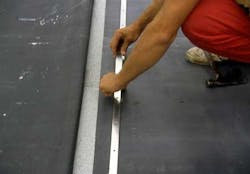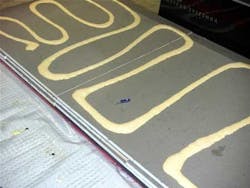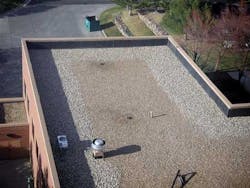Recent Buildings.com Roofing News e-newsletters have followed the U.S. Corps of Engineers’ Commentary on Roofing Systems (mainly sections on bituminous and modified bituminous [MB] roofing). This column moves on to higher technology roofing – thermoset elastomers, especially ethylene propylene diene monomer rubber (otherwise known as EPDM).
Single-Ply Roofing
While built-up roofing (BUR) utilizes multiple layers of reinforcing and field-applied bitumen for the waterproofing, many MB systems use just two factory-coated sheets. EPDM goes even further, using just single layers of rubber and reduces field seaming by offering sheets in widths up to 50 feet. Many of these EPDM sheets also eliminate internal reinforcement entirely. While EPDM is the polymer of choice today, other elastomers have been used in the recent past, including butyl rubber, neoprene (chloroprene), polyepichlorohydrin, and Hypalon® (chlorosulfonated polyethylene or CSPE).
Basics of EPDM Rubber Roofing
- The polymeric component is a blend of polyethylene and polypropylene with a small amount of an unsaturated diene, a monomer that contains multiple double bonds through which cross linking or vulcanization can take place.
- Carbon black (consisting of extremely fine carbon particles) is added to act as an ultraviolet screening agent, as well as to increase the modulus of elasticity (increased tensile and tear resistance).
- Inert fillers such as limestone reduce membrane costs.
- Extending oil permits greater loading of low-cost fillers.
- Curing agents, processing aids, and catalysts.
- Fire retardants.
- UV- or ozone-resisting additives.
While most EPDM sheets are compounded with carbon black, white rubber has been attempted without much success. Currently, if a white roof is desired, a white coating is field applied after the EPDM membrane installation is completed.
EPDM membranes may be non-reinforced, generally for ballasted systems, or they may have internal scrim reinforcement for mechanically fastened systems where concentrated stresses are expected. Typical product thicknesses are 1.1 millimeters (or 0.045 inches), 1.5 millimeters (or 0.060 inches), and 2.2 millimeters (or 0.090 inches). MB sheets are typically 4 millimeters for cap sheets and 3.5 millimeters for base sheets. Fire-retardants sheets are available, but are not required to meet the building code when ballast is to be applied.
Logistics with Rubber Roofing
If giant rolls are used, the main advantage is to reduce the number of seams that have to be formed in the field; however, these tarps may weigh 1 ton or more and require special hoisting and transportation techniques so that the deck is not overloaded during construction. Giant rolls would not be effective on a roof where there are many penetrations, so narrower rolls are used.
Field Conditions
Wind can be a real problem, not only when working with the large sheets, but also when adhesive is applied to the substrate. Debris can blow into the wet adhesive, forming lumps and affecting the quality of bonding to the substrate.
Solvent fumes can carry into occupied spaces, resulting in occupant complaints. This may require shutting down air-intake equipment or constructing temporary elevated intake ducts to avoid problems.
With loose-laid ballasted systems, temporary ballast is needed as work progresses so that the roof does not billow or blow off before it is even completed. For ballasted roof design, refer to ANSI/SPRI document RP-4 (download this for free from the Single Ply Roofing Industry’s website) that considers wind loading, parapet height, etc. RP-4 is referenced in most U.S. and Canadian building codes.
Sheets should be installed so that side-laps of sheets run parallel to the slope or are shingled in such a fashion that water does not “buck” the laps. If this cannot be avoided, batten strips of rubber can be laid over the seams to add an extra measure of protection. (A minimum slope of 0.25 inches per foot [2 percent] is recommended for all low-slope roofing systems.)
For adhered systems, the substrate must be one that is approved by the system supplier. Higher-density products provide improved impact resistance. Perlite board is not acceptable due to its relative dusty surface and low peel resistance. Newer products such as mineral fiber-based Coverboard® have a higher density and better peel resistance.
Energy Considerations
MB and single-ply systems require far less petroleum-based material than traditional bituminous build-up roofing.The most spectacular comparison would be a flood-coat and gravel surfacing on a BUR, which requires 7.5 gallons (60 pounds) of asphalt per roofing square, while a single-ply roof requires none.
While much attention has recently been paid to ENERGY STAR® reflective surfacings (most of which are white), an excellent case can be made for alternatives such as adding additional thermal insulation, the use of ballast with its increased thermal mass (thermal lag), and protected and vegetated roofs.
Aesthetics
Aesthetics are typically not much of a concern in low-slope construction. If they are, select ballast and/or paver combinations that are relatively pleasing to the eye. Some concern has been expressed that white membranes may be objectionable due to excess glare and may be slippery when ice films are present. (Black membranes look darker when wet while white membranes show no difference in appearance.)
Design Considerations and Alerts
In loosely laid membranes, some membrane contraction (manifested by pulling away from curbs and walls) has been observed. Both the National Roofing Contractors Association (NRCA) and Midwest Roofing Contractors Association (MRCA) have published guidelines for repairing this condition, titled Repair Methods for Re-Attaching EPDM Membrane and Flashing Experiencing Shrinkage. Newer membrane systems incorporate edge restraint strips (mechanically fastened reinforced rubber strips that are adhered to the field membrane).
EPDM membranes are vulnerable to oils, fats, and greases. The membrane will absorb these oils and swell up, as well as become jelly-like. Solutions to this problem include placing grease traps at exhaust vents or the substitution of an oil-resistant elastomer (i.e. polyepichlorohydrin or Neoprene) in affected roof areas.
Fleece-backed EPDM has been used as a separator when the substrate consists of an old bituminous roof containing soft bitumen (e.g. coal-tar pitch, Type I asphalt, asphalt mastic, or a resaturant).
Ballasted systems are limited to a maximum slope of 2 inches per foot (8 percent). Adhered systems using fire-retarded sheets can meet code at virtually any slope to vertical.
Experience with EPDM
As early as 1980, EPDM had captured 40 to 45 percent of the single-ply market. This is not to say that the EPDM systems have not been improved over this time period. Flashing material now uses either uncured EPDM or membrane material, replacing uncured neoprene that weathered poorly. Adhesives and primers have also improved, with self-adhesive tape replacing solvent-based neoprene and butyl liquid adhesives. Fleece backing and low-rise adhesives have provided versatility on substrates that were not conducive to mechanically fastened or ballasted systems.
Using EPDM in High Wind Exposures
ANSI/SPRI RP-4 addresses concerns with all single-ply ballasted roof systems, not just EPDM. In brief, larger ballast stones at greater weight (i.e. 20 psf instead of 10 psf) can be used in corners, perimeters, or even the entire roof, when desired. Adding parapets greatly improves both wind resistance and the possibility of wind scour.
ANSI/SPRI FX-1 provides a field test procedure for determining the withdrawal resistance of roofing fasteners from existing roof decks, and ANSI/SPRI ES-1 covers wind design of edge systems.
The National Research Council Canada, Institute for Research in Construction (NRC-IRC) has published A Guide for the Wind Design of Mechanically Attached Flexible Membrane Roofs. Copies of the guide can be ordered from NRC’s virtual store.
Substrates and Underlayments
For ballasted systems, molded expanded polystyrene (MEPS) insulation is very cost effective; however, MEPS is vulnerable to heat exposure, so a newly installed black EPDM membrane must be protected with ballast on hot, sunny days to avoid cell collapse of the foam.
For adhered membrane systems, the underlayment must be membrane-supplier approved, as low shear or dusty products could cause bonding problems. In addition, some Isoboard facers have delaminated in service, so membrane suppliers generally require the use of “approved” Isoboard insulations.
In regions that experience hailstorms with large hail (greater than 1.5 inches in diameter), higher density substrates have proven effective, as well as the use of thicker membranes (e.g. 90 mil instead of 45 mil material). Rounded stone ballast and pavers can also be used to improve impact resistance.
Impermeable substrates or the incorporation of air/vapor barriers reduce the chances of roof flutter, fastener back-out, or membrane fatigue.
For roofs exposed to considerable roof traffic, walkways of recycled rubber pads have been used. (It is difficult to walk over large round stones.) Placing fleece padding under concrete pavers is recommended, as the fleece facilitates water migration from under the pavers, reducing the chance for freeze-thaw degradation.
It is good practice to avoid having field-fabricated seams in ponded areas such as at drain sumps.
Flashings and Penetrations
Vertical flashings for most EPDM systems do not require a cant strip, as the EPDM sheets are very flexible; however, edge restraint and termination bars are used to keep the flashing and membrane in place.
Circular pipe penetrations are weatherproofed by the use of “witches hats” (flexible EPDM boots) that are bonded to the horizontal roof membrane and clamped to the pipe. For multiple or angular penetrations in a small area, pitch-pockets can be used. Instead of the bituminous filler customarily used for BUR and MB systems, curing elastomeric compounds are used (either catalyzed or moisture-curing).
EPDM Specifications in Roofing and Waterproofing:
Since the Corps of Engineers’ document was published in 1999, a number of additional EPDM specifications have been published:
- ASTM D4811 – Standard Specification for Nonvulcanized (Uncured) Rubber Sheet Used as Roof Flashing.
- ASTM D4637 – Standard Specification for EPDM Sheet Used In Single-Ply Roof Membrane.
- ASTM D6134 – Standard Specification for Vulcanized Rubber Sheets Used in Waterproofing Systems.
- ASTM D6369 – Standard Guide for Design of Standard Flashing Details for EPDM Roof Membranes.
- ASTM D6383 – Standard Practice for Time-to-Failure (Creep-Rupture) of Adhesive Joints Fabricated from EPDM Roof Membrane Material.
- ASTM D6769 – Standard Guide for Application of Fully Adhered, Cold-Applied, Prefabricated Reinforced Modified Bituminous Membrane Waterproofing Systems.
- ASTM D6950 - Standard Practice for Application of Heat Weldable Atactic Polypropylene (APP) Modified Bituminous Waterproofing Membranes Systems for New Building Decks.
Resources
- ASTM Intl. (formerly known as the American Society for Testing and Materials)
- National Research Council of Canada’s Institute for Research in Construction
- National Roofing Contractors Association
- Single Ply Roofing Industry
- Unified Facilities Criteria: Commentary on Roofing Systems
About the Author
Richard L. Fricklas
Richard (Dick) L. Fricklas received a Lifetime Achievement Award and fellowship from RCI in 2014 in recognition of his contributions to educating three generations of roofing professionals. A researcher, author, journalist, and educator, Fricklas retired as technical director emeritus of the Roofing Industry Educational Institute in 1996. He is co-author of The Manual of Low Slope Roofing Systems (now in its fourth edition) and taught roofing seminars at the University of Wisconsin, in addition to helping develop RCI curricula. His honors include the Outstanding Educator Award from RCI, William C. Cullen Award and Walter C. Voss Award from ASTM, the J. A. Piper Award from NRCA, and the James Q. McCawley Award from the MRCA. Dick holds honorary memberships in both ASTM and RCI Inc.



